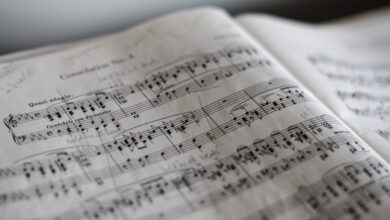The Role of Instruments in Ritual and Ceremony: Sacred Music Traditions

In the rich tapestry of human culture, music has always played a profound role in uniting communities, expressing emotions, and invoking spiritual experiences. No occasion showcases this musical significance more than ritual and ceremony, where instruments take center stage, infusing sacred traditions with enchanting melodies. The diverse array of sacred music traditions around the world is a testament to the universal language that music speaks, connecting people across time and space.
From the majestic sound of church organs reverberating through grand cathedrals to the rhythmic beats of drums filling ancient temples, instruments have a transformative power in religious rituals. Their melodic notes can transport worshippers to a higher realm, evoking a sense of awe and reverence. Through their unique timbres and vibrations, instruments become conduits for divine expression, enabling individuals to connect with the transcendent.
Consider the haunting melodies of the Indian sitar or the soul-stirring strains of the Native American flute. These instruments not only accompany religious ceremonies but also hold symbolic significance within their respective cultures. They embody the spirit of the religious tradition, acting as vessels for conveying prayers, chants, and hymns to the divine. Just as each tradition carries its distinct rituals and beliefs, the instruments used reflect the cultural identity and spiritual practices of the community.
Instruments also serve as catalysts for communal participation during rituals and ceremonies. The harmonious interplay between musicians and worshippers creates a collective energy that binds individuals together. Like a symphony conductor, the rhythm and melody guide participants through the spiritual journey, fostering a sense of belonging and oneness. The uplifting power of music unites hearts and minds, transcending language barriers and cultural differences.
Moreover, instruments lend an experiential dimension to sacred rituals, heightening the emotional impact on participants. The pulsating beats of drums awaken primal instincts, stirring the soul and inviting ecstatic dance. The soft strains of a harp or the delicate plucking of strings on a guitar can evoke introspection and contemplation. These instruments serve as emotional triggers, enhancing the transformative nature of religious experiences.
The role of instruments in ritual and ceremony within sacred music traditions is profound and multifaceted. They amplify the spiritual journey, connect individuals with the divine, foster community participation, and evoke powerful emotions. Across cultures and continents, these enchanting melodies and captivating rhythms continue to elevate religious practices to new heights, leaving an indelible imprint on the human spirit.
Harmonizing the Divine: The Transformative Power of Sacred Music in Ritual and Ceremony

When we think about rituals and ceremonies, our minds often conjure up images of ancient traditions, sacred spaces, and a sense of profound spirituality. One element that consistently weaves through these timeless practices is the captivating power of sacred music. From the haunting chants in monasteries to the soul-stirring hymns in grand cathedrals, music has an extraordinary ability to connect us with the divine.
Sacred music serves as a conduit, a channel through which we can transcend the boundaries of the physical realm and reach higher states of consciousness. It possesses the unique potential to uplift our spirits, unite communities, and transform ordinary moments into extraordinary ones. Whether it be the rhythmic beats of tribal drums or the ethereal melodies of a choir, these sonic expressions have a profound impact on our hearts and souls.

The enchanting rhythms and harmonies of sacred music create a sacred space within our beings, allowing us to detach from the mundane and immerse ourselves in a transcendent experience. Each note resonates with the energy of the divine, invoking emotions that awaken our spiritual essence. Through this harmonious connection, we find solace, inspiration, and a deep sense of belonging.

Moreover, sacred music serves as a unifying force, bringing people together in celebration, prayer, and reflection. It transcends language barriers, cultural differences, and personal beliefs, reminding us of our shared humanity. In the collective experience of chanting, singing, or simply listening, we become part of something greater than ourselves—a tapestry of voices blending in perfect harmony.
Just as every ceremony or ritual holds its unique purpose, sacred music adapts to the occasion. It can evoke reverence, instill peace, ignite joy, or even facilitate healing. The power of sound intertwined with intention creates a transformative atmosphere, where the mundane transforms into the sacred, and the ordinary becomes extraordinary.
Sacred music possesses a transcendent power that harmonizes the divine within us. It enriches our spiritual journey, fosters unity, and transforms mundane moments into extraordinary ones. Whether experienced in grand cathedrals, humble temples, or the heart of nature, the enchanting melodies and rhythms of sacred music have the ability to transport us to realms where the divine and human intertwine, leaving an indelible mark on our souls.
From Ancient Chants to Modern Ensembles: Tracing the Evolution of Sacred Music Instruments
Have you ever wondered about the captivating melodies that have transcended time and touched the depths of our souls? Sacred music, with its divine resonance, has been an integral part of human culture for centuries. One cannot explore sacred music without acknowledging the instrumental elements that bring these ethereal compositions to life. In this article, we embark on a journey through time, tracing the evolution of sacred music instruments from their ancient roots to the harmonious ensembles of the present day.
Our voyage begins in the mists of antiquity, where the earliest traces of sacred music instruments emerge. Picture yourself in ancient temples and religious rituals, where chants echoed through grand halls. These early musical expressions relied heavily on simple, yet profound, instruments such as flutes, drums, and rattles. These primal tools possessed a mystical power, believed to bridge the gap between the physical and spiritual realms.
As civilizations grew, so did the complexity of sacred music. The medieval era witnessed a blossoming of musical artistry, with the emergence of new instrument families. Strings became prominent, introducing instruments like the lute, harp, and lyre. The delicate plucking and resonant tones beautifully accompanied the soaring voices of choirs, creating an enchanting harmony that transported worshippers to celestial realms.
With the advent of the Renaissance, sacred music reached new heights of grandeur. Instrument makers crafted intricate masterpieces, expanding the range and capabilities of existing instruments. The organ, with its majestic pipes, took center stage in cathedrals, evoking awe and reverence. Meanwhile, the Baroque period ushered in the era of orchestras, featuring a rich assortment of instruments like violins, cellos, trumpets, and oboes. These ensembles added depth and drama to religious compositions, leaving listeners spellbound.
Fast forward to the present day, where sacred music instruments have embraced technological advancements. Synthesizers, electronic keyboards, and digital samplers have found their place in contemporary worship settings, blending traditional sounds with modern innovation. This fusion of old and new allows for greater versatility and experimentation, enabling musicians to create captivating sonic landscapes that resonate with diverse audiences.
Sacred Sounds Unveiled: Exploring the Global Diversity of Instruments in Ritualistic Music Traditions
Have you ever wondered about the enchanting and diverse world of instruments used in ritualistic music traditions around the globe? These sacred sounds have the power to transport us to mystical realms, connecting us with ancient spiritual practices. Join us on a captivating journey as we explore the rich tapestry of musical instruments that grace these profound rituals.
In India, the resonating tones of the sitar invoke a meditative state and are often heard in Hindu ceremonies. Its soul-stirring melodies carry the essence of devotion, filling the air with a sense of transcendence. The sitar’s strings seem to whisper the secrets of the universe, enveloping listeners in a cocoon of deep introspection.
Venturing to the rainforests of Africa, we encounter the mesmerizing rhythms produced by the djembe. This goblet-shaped drum, crafted from a single piece of wood, pulsates with energy and vitality. When played with skilled hands, it evokes a primal connection to nature, stirring the souls of participants in tribal rituals. The djembe’s beats echo through the night, uniting communities in rhythmic harmony.
Traveling to the Andean highlands of South America, we discover the haunting melodies of the pan flute. Consisting of a row of hollow tubes, this instrument is played by blowing across their open ends. As the warm breath of the musician dances through the pipes, the pan flute exudes an ethereal resonance that mirrors the windswept landscapes. It carries deep significance in indigenous rituals, serving as a conduit between earthly realms and the spirit world.
Crossing the expansive deserts of the Middle East, the melancholic strains of the oud captivate the heart. With its pear-shaped body and ancient origins, this stringed instrument has been cherished for centuries. Its sorrowful yet captivating melodies echo the human experience, evoking emotions that transcend language and culture. The oud’s timeless resonance enchants listeners during sacred ceremonies, invoking a profound sense of introspection.
As we peel back the layers of these ritualistic music traditions, we uncover a mosaic of sonic expressions that unite humanity across geographical boundaries. Each instrument tells a unique story, carrying with it the collective wisdom and spiritual yearning of generations past. Through their sacred sounds, we gain glimpses into the depths of human existence, reminding us of our shared journey in this vast universe.
So, next time you encounter the enchanting melodies of ritualistic music, let yourself be carried away by the magical tapestry of instruments that have been revered for centuries. Immerse yourself in the diverse world of sacred sounds, and let them unveil the mysteries of our shared human experience.
Beyond Words: How Instruments Add a Spiritual Dimension to Sacred Ceremonies

Introduction:
Have you ever wondered how music can transcend language and touch the depths of our souls? In sacred ceremonies around the world, instruments play a profound role in elevating the spiritual experience. They have the power to transport us beyond the limitations of words, connecting us to something greater than ourselves. In this article, we will explore the captivating realm where instruments merge with sacred ceremonies, creating a harmonious blend of sound and spirituality.
Unleashing the Power of Sound:
Instruments possess a unique ability to communicate emotions that often elude verbal expression. Through haunting melodies or uplifting rhythms, they tap into the essence of human emotions, evoking joy, sadness, awe, and reverence. Whether it’s the soulful strains of a flute, the rhythmic beats of drums, or the ethereal sounds of a harp, each instrument adds its distinct voice to the symphony of the sacred ceremony.
Creating Sacred Spaces:
Just as the physical space of a sacred ceremony holds significance, so does the sonic atmosphere. Instruments serve as conduits, transforming mundane spaces into hallowed grounds. Their resonant vibrations infuse the air with a tangible energy, setting the stage for spiritual connection. The acoustic qualities of instruments can enhance the potency of rituals, allowing participants to immerse themselves fully in the experience.
A Universal Language:
No matter where you are in the world, music is a universal language that transcends cultural boundaries. Instruments enable communication between diverse individuals, fostering unity and harmony within sacred ceremonies. They facilitate a shared experience, where people from different backgrounds can come together, guided by the common thread of melodic enchantment.

Symbolism and Significance:
Beyond their auditory allure, instruments often carry symbolic meaning in sacred ceremonies. From the shaman’s drum that echoes the heartbeat of the Earth to the sacred bell that symbolizes awakening, these objects become vessels of spirituality. Their significance goes beyond their physical presence, acting as bridges between the earthly and the divine.
Conclusion:
Instruments hold the power to transport us to a realm where words fall short, enabling us to connect with the divine during sacred ceremonies. They evoke emotions, create sacred spaces, foster unity, and carry deep symbolism. So next time you find yourself in the midst of a sacred ceremony, immerse yourself in the enchanting melodies and let the instruments guide you on a spiritual journey beyond words.




